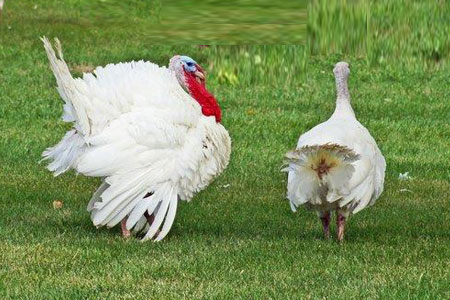
Blackhead is a serious disease of turkeys. Histomonas meleagridis protozoa cause the disease, leading to its technical name: histomoniasis. Histomonad protozoa occur in nearly all poultry environments, except where the soil is dry, loose, and sandy.
A turkey gets blackhead when histomonads lodge in the bird’s ceca, or blind intestinal pouches. From there they migrate to the liver, causing extensive damage.
Signs of Blackhead in Turkeys
Early signs of the disease include increased thirst, decreased appetite and subsequent emaciation, droopy head with eyes closed, droopy wings, and unkempt, ruffled feathers. Damaged tissue in the ceca may result in bloody droppings that initially might look like coccidiosis.
The term blackhead is misleading, because the head of an affected turkey doesn’t really get black. However, reduced oxygen in the blood causes an infected bird’s skin, including its head, to redden. As the disease progresses, an infected turkey’s droppings become watery and sulfur-yellow.
Turkeys die from either liver failure or a bacterial infection following damage caused by the protozoa. Sometimes the first sign of this disease is a dead turkey. The death rate is 80% to 100%, tending to be highest in young poults.
Where Does Blackhead Come From?
Histomonads spread from bird to bird either directly through cloacal contact during mating or by means of fresh droppings. They also spread via the most common parasitic worm in North American poultry — the cecal worm (Heterakis gallinarum).
Turkeys expel cecal worms and their eggs in their droppings. A foraging turkey gets infected with blackhead by picking up cecal worms or eggs containing histomonads. Sometimes earthworms eat infected cecal worm eggs, then infect turkeys that eat the earthworms.
Expelled histomonads that lack the protection of a cecal worm egg quickly die. But when protected inside a cecal worm egg that in turn is protected inside an earthworm, they may survive in the environment for years. Controlling cecal worms is therefore the key to controlling blackhead-inducing histomonads.
Preventing Blackhead in Turkeys
Worming turkeys regularly controls cecal worms. So does not letting turkeys range with chickens or on land where any poultry have foraged within the past three years.
Turkeys may forage on such land in only two years, if it is rototilled and gardened before using it as turkey pasture. That’s because histomonads are susceptible to the drying that occurs after tilling the soil.
Although baby turkey poults and chicks may brood together, keep young growing turkeys away from older turkeys and chickens. During the growing period, pasture rotation also helps. So does periodically moving feeders, drinkers, and outdoor roosts to avoid poop concentrations in those areas.
Diagnosing and Treating Blackhead
The only way to diagnose blackhead in turkeys is through a necropsy. Positive identification is through examining ulcers in the ceca and lesions on the liver of dead turkeys.
No effective medication is currently available for preventing or treating blackhead. Reason enough to avoid this serious disease of turkeys through careful management.
And that’s today’s news from the Cackle Coop.
Gail Damerow wrote the chapter on keeping turkeys in The Backyard Homestead Guide to Raising Farm Animals.

